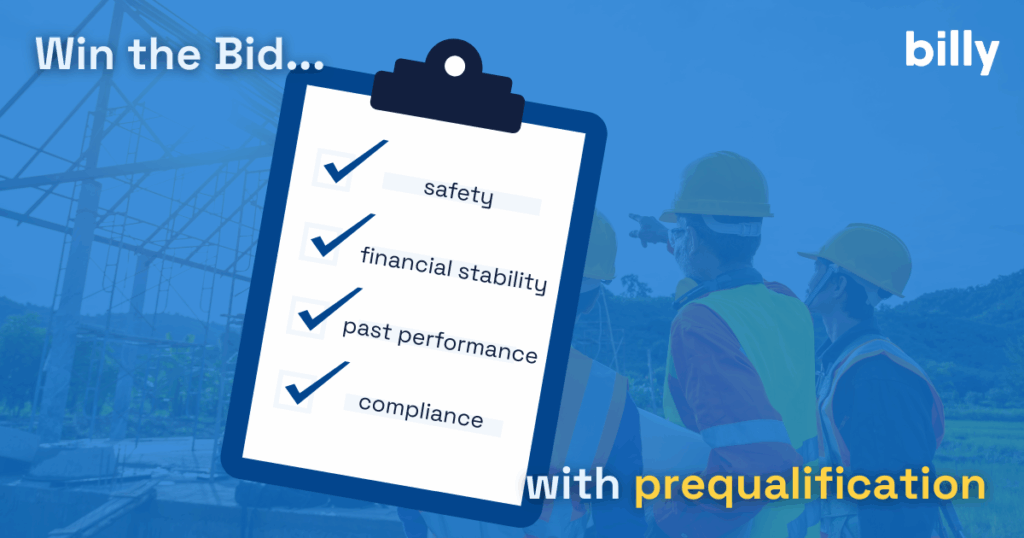In the competitive world of construction, securing jobs is a constant challenge. Prequalification can be your secret weapon. It’s a process that showcases your capabilities and reliability to potential clients.
By effectively implementing prequalification, you can significantly increase your chances of winning more projects. This process involves evaluating key aspects like financial stability and past performance.
Digital technology and automation (like Billy’s prequalification tool!) can streamline this process, making it more efficient. A well-structured prequalification checklist ensures you gather all necessary information.
Understanding and applying prequalification can set you apart from competitors. It’s not just about compliance; it’s about building trust and long-term partnerships.
What Is Prequalification and Why Does It Matter?
Prequalification is a foundational step in the construction bidding process. It allows project owners to assess a contractor’s qualifications before granting them project opportunities. This assessment includes evaluating financial health, performance history, and compliance records.
For contractors, prequalification is an avenue to showcase their strengths. It’s a chance to demonstrate reliability, expertise, and commitment to industry standards. By highlighting these attributes, contractors make themselves more attractive to potential clients.
The importance of prequalification cannot be overstated. It serves as a risk management tool for project owners, ensuring only capable contractors are chosen. This process mitigates risks and fosters trust and transparency between contractors and clients.
The Prequalification Process: Step-by-Step
The prequalification process is structured to evaluate all aspects of a contractor’s capabilities. The first step involves gathering essential documents such as financial statements and safety records. This documentation provides a baseline for assessing the contractor’s reliability.
Next, contractors undergo a thorough review of past project performance. This review includes analyzing timelines, quality of work, and client feedback. Such a review helps build a comprehensive picture of the contractor’s ability to deliver.
After evaluating past work, a detailed assessment of compliance with industry standards follows. This step ensures all regulatory and legal obligations are met, reducing future liabilities.
Subsequently, a safety performance review is conducted, focusing on safety training records and incident reports. High safety standards are crucial for maintaining project integrity and minimizing risks.
The process culminates in a scoring system where each aspect is rated. The scores determine a contractor’s eligibility for project bidding. This system promotes fairness and transparency in contractor selection.
Key steps in the prequalification process include:
- Document collection and analysis
- Reviewing past project performance
- Compliance and safety evaluation
- Scoring and assessment for eligibility
Overall, a systematic prequalification process ensures that only the most capable contractors are considered. It lays the groundwork for successful project outcomes.
Building a Robust Prequalification Checklist
Creating a thorough prequalification checklist is crucial for streamlined evaluation. A comprehensive checklist ensures all necessary information is gathered and assessed. It provides a consistent framework for contractors to follow.
The checklist should start with basic company details like legal name and contact information. This ensures easy identification and communication throughout the process. Next, include sections for financial stability indicators such as recent tax returns and credit ratings. These details help in determining a contractor’s economic health.
It’s important to cover past project experience, including references and performance history. This part of the checklist provides insights into the contractor’s expertise and reliability. Safety records are also vital, focusing on incident logs and safety training programs.
An effective checklist not only simplifies the prequalification process but also enhances data accuracy. It ensures that no critical detail is overlooked, ultimately leading to better project outcomes.
Leveraging Digital Technology and Automation in Prequalification
Digital technology is transforming the prequalification process, making it faster, more efficient, and less burdensome for contractors and project owners alike. Automation takes this a step further by streamlining data collection, validation, and analysis.
With Billy, contractors and project owners can centralize and update critical prequalification information in real time. The platform ensures data is always current, easy to access, and securely stored — eliminating the need for scattered spreadsheets or manual processes.
Billy’s automation tools also minimize human error, delivering accurate compliance data and reducing administrative overhead. Stakeholders can collaborate more effectively by sharing information seamlessly across teams and projects, cutting down on back-and-forth communication.
Key benefits of leveraging Billy for prequalification include:
- Enhanced data accuracy through automated compliance tracking
- Centralized and accessible data management
- Improved efficiency, saving both time and resources
Real-world example: Check out how Gardner Builders leverages a customized Billy prequalification form.

Compliance and Risk Reduction Through Prequalification
Prequalification plays a vital role in ensuring compliance with industry standards. It aids in identifying contractors who consistently meet regulatory requirements. This reduces the risk of penalties and project delays.
By rigorously evaluating contractors, prequalification minimizes potential risks. It ensures only capable parties are considered for projects. This careful screening process safeguards project owners and stakeholders.
Key compliance benefits of prequalification include:
- Ensures adherence to industry standards
- Mitigates risks and potential liabilities
- Enhances project reliability and success
Incorporating a robust prequalification system promotes transparency and accountability. It builds trust between project managers and contractors. This proactive approach enhances overall project success and sustainability.
Practical Strategies for Success: Tips for Project Managers and Compliance Officers
For construction project managers, integrating a systematic prequalification process can be transformative. Start by defining clear criteria that align with project goals. This clarity helps in selecting the right contractors effectively.
Compliance officers can enhance efficiency by leveraging checklists. These ensure all legal and regulatory standards are covered. Regular updates to these checklists are crucial to stay compliant with evolving regulations.
To maximize the benefits of prequalification, consider these strategies:
- Engage in continuous learning about industry changes
- Foster open communication with contractors
- Utilize digital tools for efficient data management
Implementing these strategies strengthens the prequalification process. This boosts compliance, reduces risks, and enhances project success rates, providing a strong competitive edge.
Making Prequalification Your Competitive Advantage
Prequalification stands as a vital component in construction project success. It goes beyond merely ticking boxes to assessing true capability. This process helps ensure quality, compliance, and timely delivery.
The continuous evolution of industry standards demands dynamic prequalification strategies. The better your system, the higher your chances of securing projects. By embracing digital solutions and automation, you streamline tasks, thus enhancing accuracy and efficiency.
In a competitive market, distinguishing yourself is key. A robust prequalification process supports this. It not only showcases commitment to compliance but also highlights a dedication to quality and reliability. This positions you favorably, making prequalification your decisive competitive advantage.
With Billy, contractors can transform prequalification from a manual headache into a competitive edge. Centralize compliance data, automate document collection, and simplify communication with stakeholders—all in one platform. Start making prequalification your competitive advantage with Billy today.
Frequently Asked Questions
Project owners typically review financial stability, insurance coverage, safety records, compliance history, and past project performance. These factors help determine whether a contractor can handle the scope, risk, and requirements of a new project.
By reviewing safety training records, incident reports, and regulatory compliance before a project begins, prequalification ensures only contractors with strong safety practices and compliance histories are selected. This reduces risks and promotes smoother project execution.
Prequalification acts as a screening tool that minimizes financial, safety, and performance risks. It allows project owners to identify reliable contractors upfront, lowering the chances of costly delays, non-compliance issues, or substandard work.






